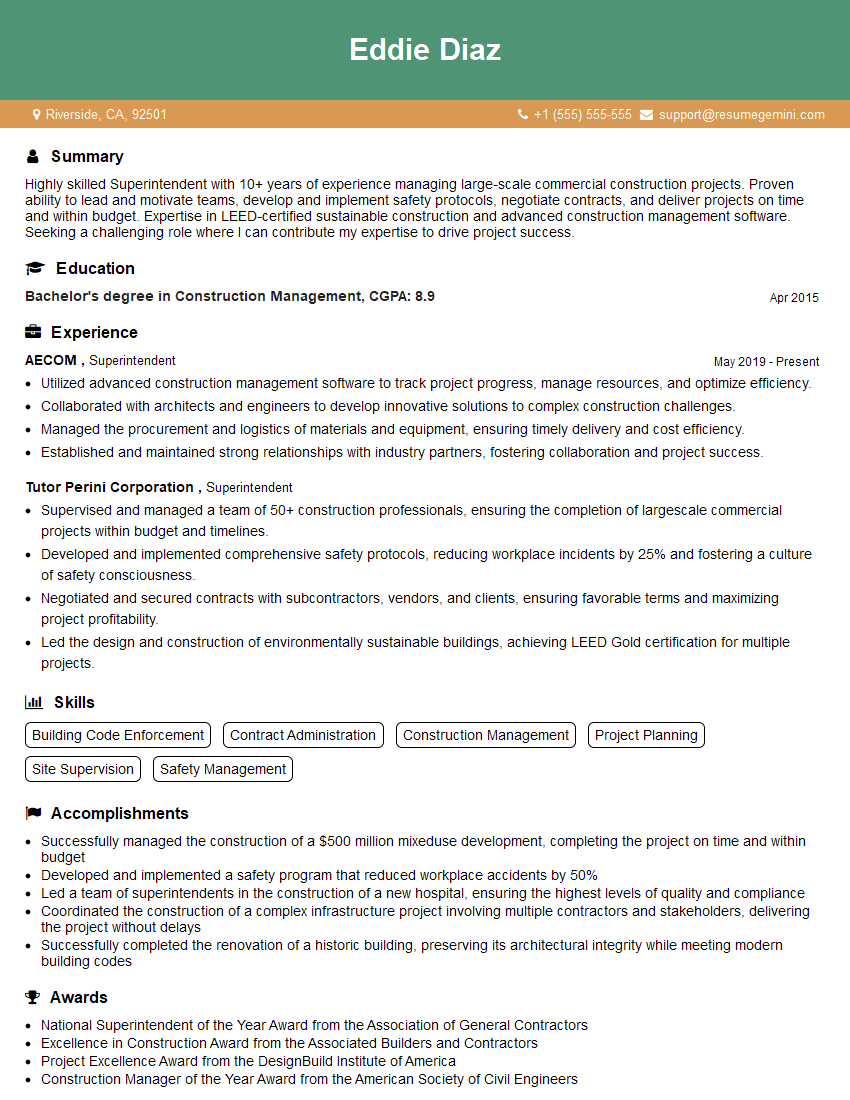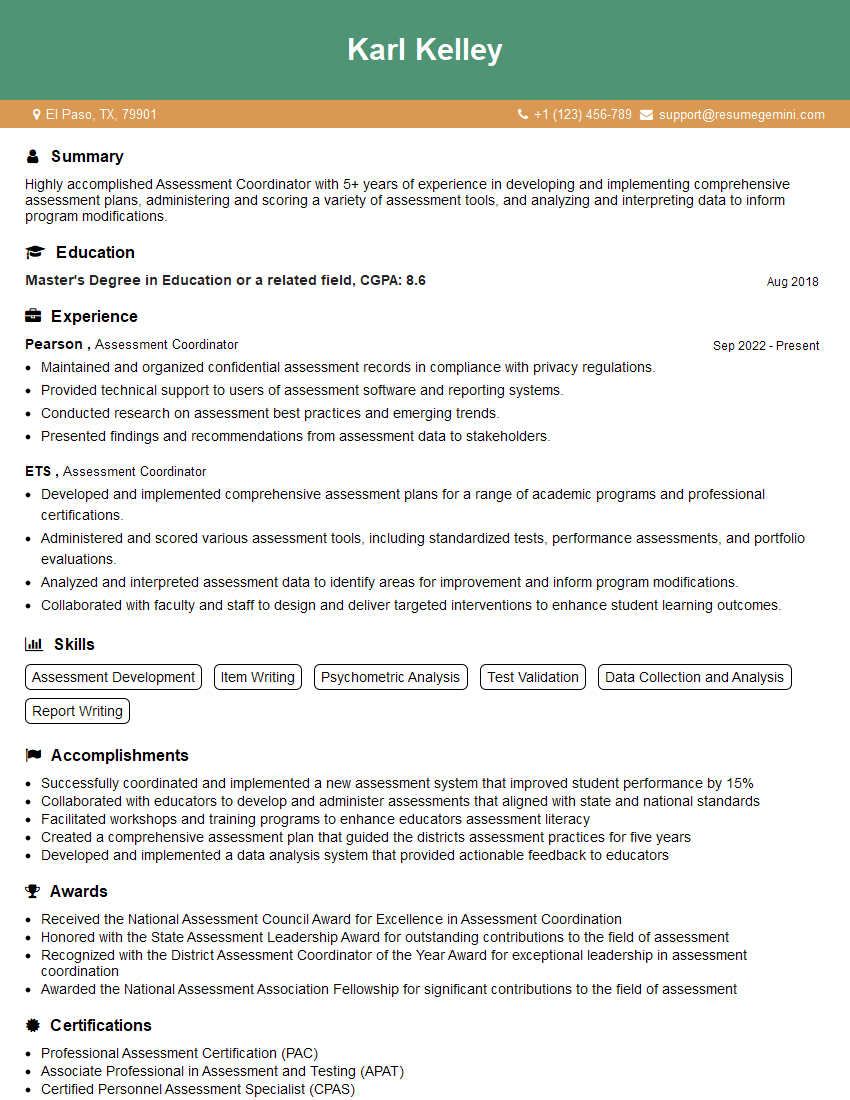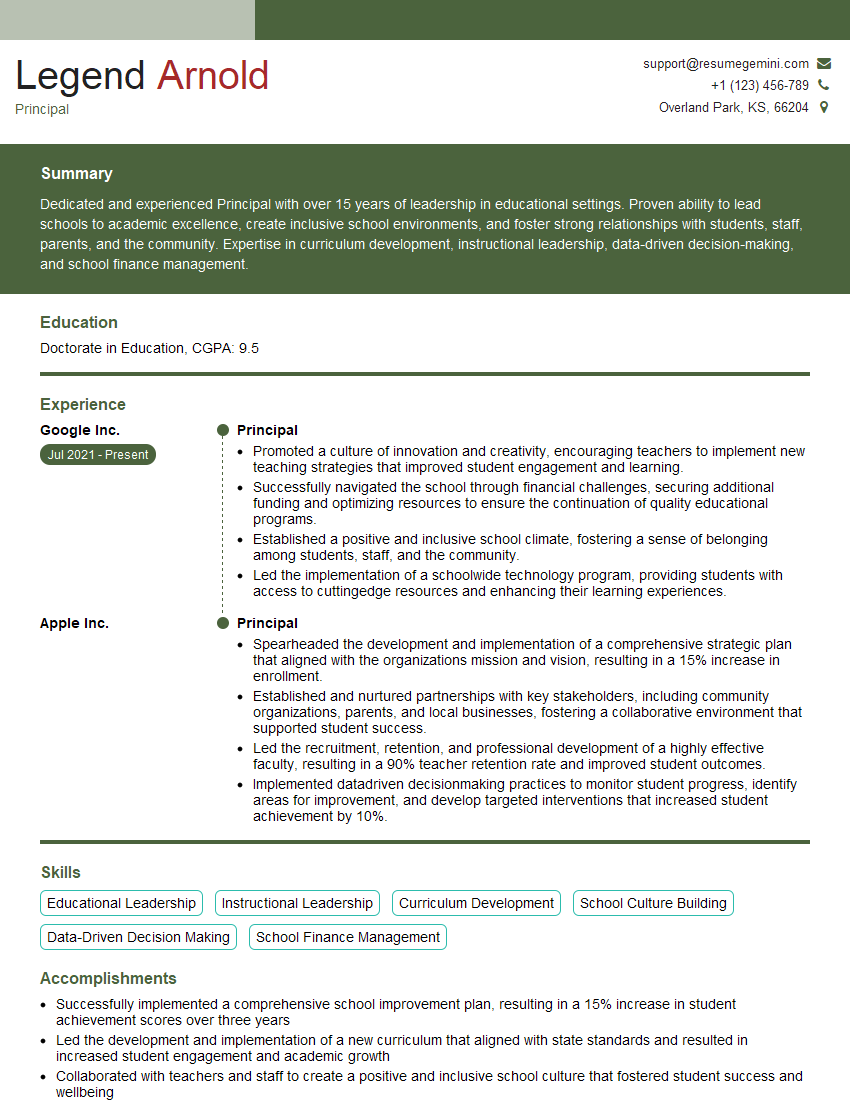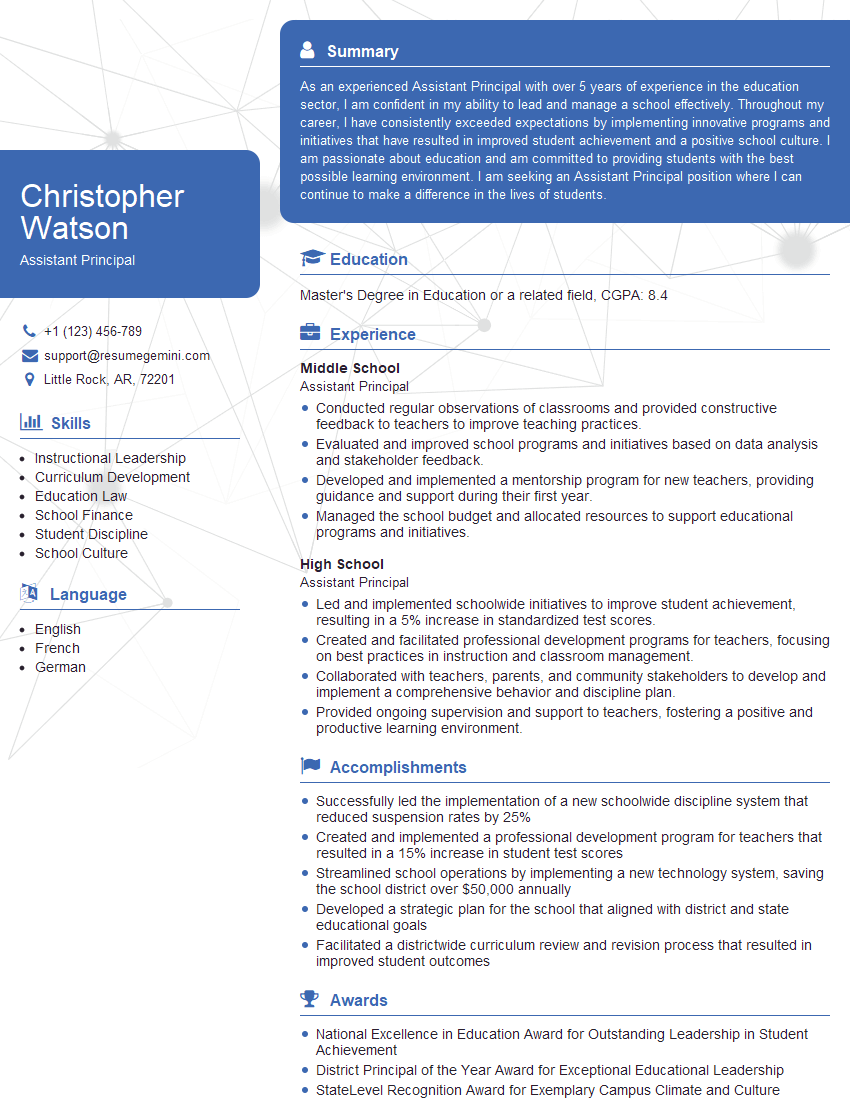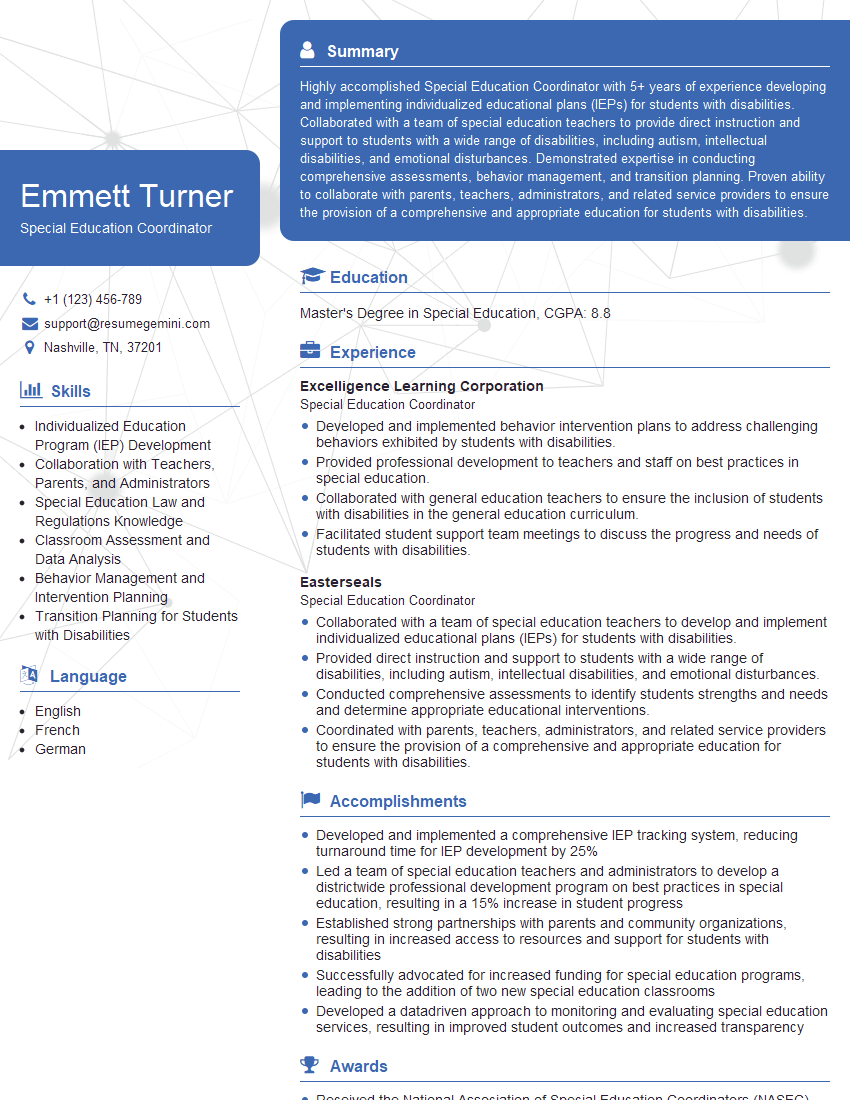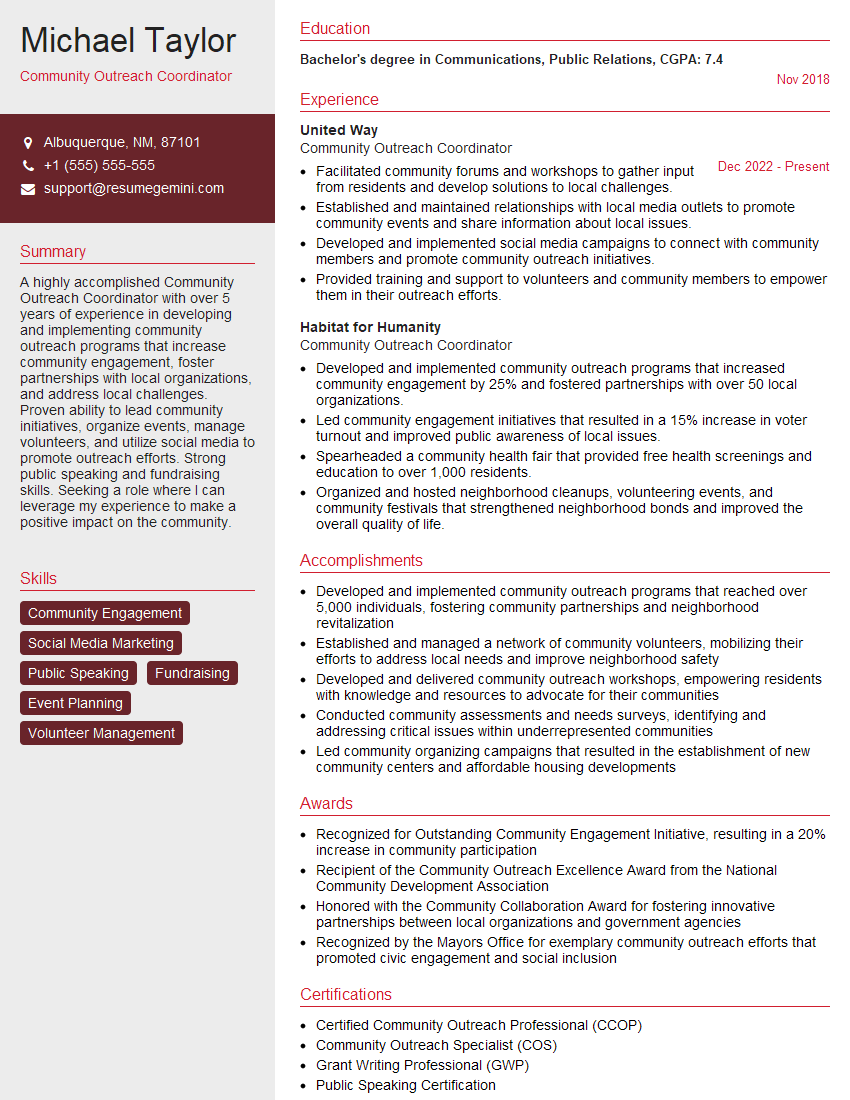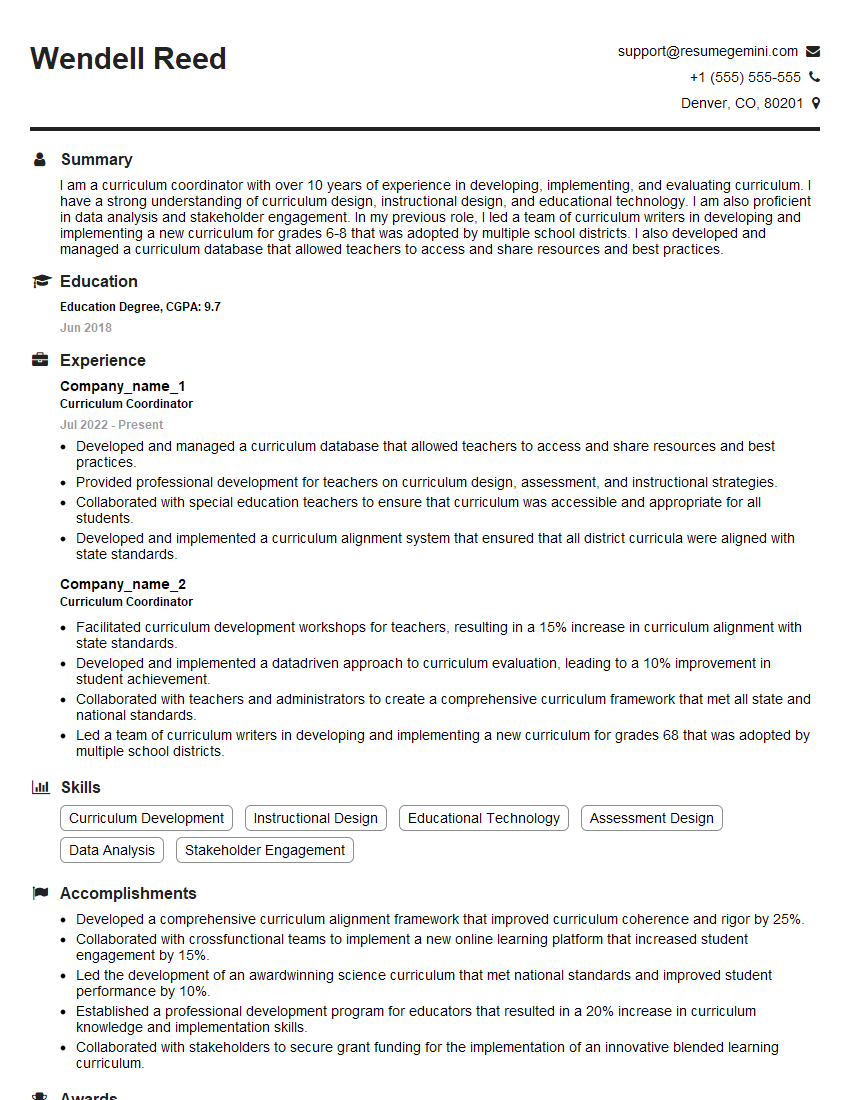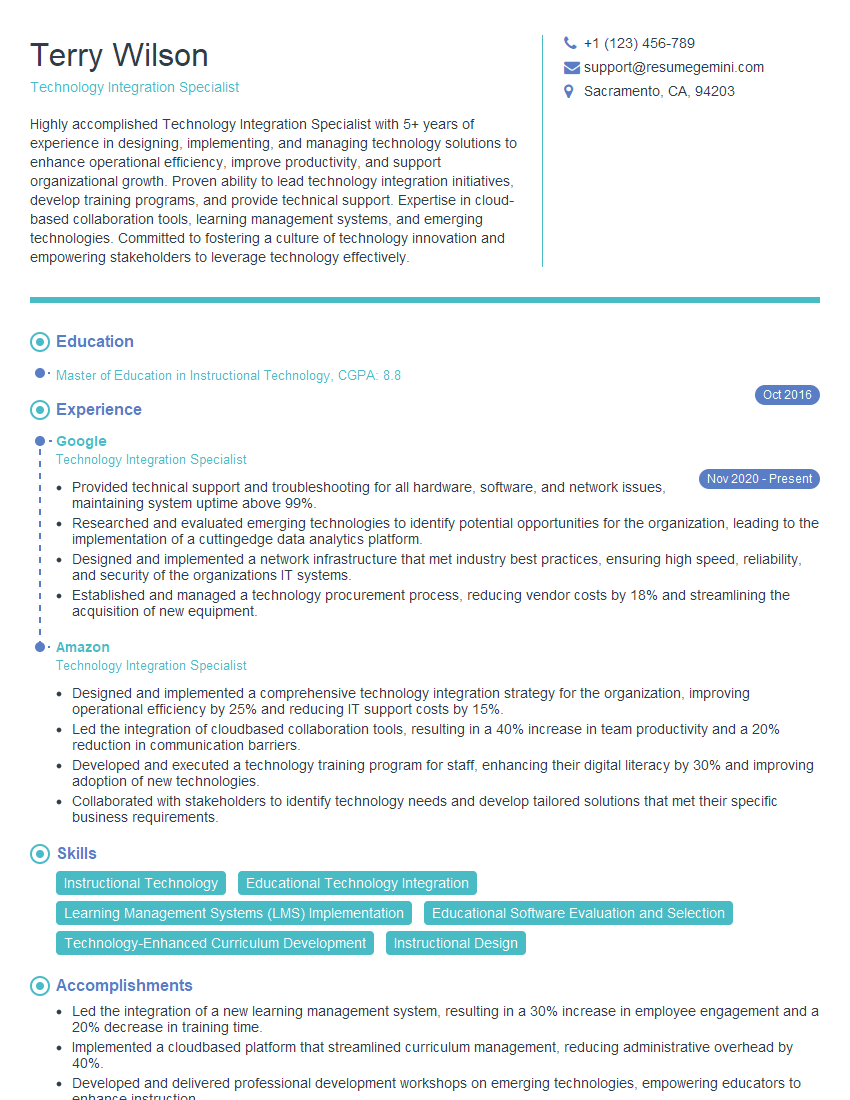Unlock your full potential by mastering the most common School-Wide Collaboration interview questions. This blog offers a deep dive into the critical topics, ensuring you’re not only prepared to answer but to excel. With these insights, you’ll approach your interview with clarity and confidence.
Questions Asked in School-Wide Collaboration Interview
Q 1. Describe your experience fostering collaborative relationships among diverse stakeholders in a school setting.
Fostering collaboration among diverse stakeholders – including teachers, administrators, support staff, parents, and students – requires a multifaceted approach. It’s like orchestrating a symphony; each section plays a vital role, and the conductor (in this case, the school leader) ensures harmony and effective performance.
My experience involves building relationships through open communication, actively soliciting input from all stakeholders, and establishing clear expectations and shared goals. For example, in my previous role, I initiated a school-wide improvement team comprised of representatives from each department. This team met regularly to discuss challenges, brainstorm solutions, and collaboratively develop action plans. We utilized collaborative tools such as shared online documents and project management software to ensure transparency and efficient communication. Regular feedback mechanisms, including surveys and informal check-ins, helped ensure everyone felt heard and valued.
Another key element was creating opportunities for informal interaction. We organized social events, team-building activities, and professional learning communities (PLCs) to foster camaraderie and mutual understanding. This helped break down silos and build trust among diverse groups, resulting in more productive collaboration.
Q 2. Explain your approach to building consensus among teachers with differing pedagogical approaches.
Building consensus among teachers with differing pedagogical approaches requires a deep understanding of various teaching philosophies and a commitment to finding common ground. It’s not about forcing conformity but rather finding a shared vision and identifying areas of convergence. My approach begins with active listening and respectful dialogue. I encourage teachers to share their perspectives and rationale, validating their expertise and experience.
I facilitate structured discussions using collaborative problem-solving techniques. For example, we might use a ‘fishbone’ diagram to identify the root causes of a particular challenge or employ a ‘think-pair-share’ activity to explore diverse viewpoints on a specific pedagogical approach. The focus is on exploring the underlying principles of teaching and learning rather than on specific methodologies. We often find that while the surface-level approaches might differ, the core values and desired learning outcomes are often shared.
Furthermore, I leverage professional development opportunities to expose teachers to diverse pedagogical strategies, fostering a deeper understanding and appreciation of different approaches. This allows them to integrate effective elements from various methods into their own practice, leading to greater flexibility and adaptability. Ultimately, the goal is to create a culture of mutual respect and shared learning, where teachers feel comfortable sharing ideas and collaborating to find solutions that work best for all students.
Q 3. How would you address resistance to school-wide initiatives from individual teachers or departments?
Resistance to school-wide initiatives can stem from various sources – fear of change, lack of understanding, perceived workload increases, or even personality clashes. Addressing this resistance requires a nuanced and empathetic approach. My strategy begins with open communication and transparency. I proactively involve those who may be resistant in the planning and implementation phases.
I explain the rationale behind the initiative, highlighting its benefits for students and teachers alike. I actively listen to their concerns, addressing them directly and honestly. If workload is a concern, I work collaboratively to redistribute tasks or provide additional support. If there’s a lack of understanding, I provide comprehensive training and ongoing mentoring. In some cases, pilot programs or smaller-scale implementations can be used to alleviate concerns and demonstrate the effectiveness of the initiative. For particularly resistant individuals, one-on-one meetings may be necessary to address specific concerns and build trust.
Ultimately, the goal is to create a sense of ownership and buy-in. When individuals feel heard, valued, and actively involved in the process, resistance is far less likely.
Q 4. Detail your experience facilitating professional development focused on collaborative practices.
Facilitating professional development focused on collaborative practices requires a shift from traditional lecture-based models to more interactive and experiential learning. My approach emphasizes active participation, peer learning, and the application of new skills in real-world classroom settings. I utilize various strategies, including:
- Collaborative Problem-Solving Workshops: These workshops engage teachers in hands-on activities that require collaborative problem-solving, such as developing curriculum collaboratively or designing assessment tools as a team.
- Mentorship Programs: Pairing experienced collaborative teachers with newer colleagues fosters knowledge sharing and provides opportunities for continuous learning and support.
- Co-teaching and Lesson Study: These strategies allow teachers to observe and learn from each other’s teaching styles and collaboratively refine their instructional practices.
- Technology Integration: Professional development should embrace the use of technology to support collaboration, such as utilizing online platforms for communication, project management, and resource sharing.
I regularly assess the impact of professional development through feedback surveys, classroom observations, and teacher reflections on their collaborative practices. This allows for continuous improvement and adaptation of the professional development program to better meet the needs of the teachers.
Q 5. Describe a time you successfully mediated conflict between teachers or staff members.
In one instance, two teachers, both highly dedicated but with very different teaching styles, were involved in a conflict regarding classroom management strategies. One favoured a more structured, traditional approach, while the other preferred a more student-centered, project-based method. This conflict was impacting student learning and the overall classroom environment.
To mediate, I initiated separate meetings with each teacher to understand their perspectives. I focused on active listening and validating their feelings and concerns. I helped them understand each other’s rationale and teaching philosophies. Then, I facilitated a joint meeting where I established ground rules for respectful communication. We collaboratively developed a compromise that involved incorporating elements of both teachers’ approaches, creating a blended learning environment that catered to diverse learning styles.
This involved creating a shared classroom management plan, which incorporated elements of both structured routines and student-led project work. The key was framing the discussion not as a clash of approaches but as a collaborative effort to optimize student learning. This successful mediation not only resolved the immediate conflict but also strengthened the working relationship between the two teachers.
Q 6. How do you measure the effectiveness of school-wide collaboration initiatives?
Measuring the effectiveness of school-wide collaboration initiatives requires a multifaceted approach that goes beyond simple metrics. While quantitative data, such as student achievement scores and teacher satisfaction surveys, are important, it’s equally crucial to gather qualitative data to understand the impact on the school’s culture and collaborative practices.
My approach includes:
- Student Achievement Data: Analyzing standardized test scores, classroom assessments, and other indicators to determine the impact of collaborative initiatives on student learning outcomes.
- Teacher Surveys and Feedback: Gathering feedback from teachers regarding their perceptions of collaboration, their satisfaction with collaborative processes, and their perceived impact on their teaching practices.
- Classroom Observations: Conducting classroom observations to assess the extent to which collaborative teaching strategies are being implemented and their effectiveness in the classroom.
- Focus Groups and Interviews: Conducting focus groups and interviews with teachers, administrators, and other stakeholders to gather qualitative data regarding the impact of collaborative initiatives on the school culture and community.
By combining quantitative and qualitative data, we can obtain a comprehensive understanding of the effectiveness of school-wide collaboration initiatives and make necessary adjustments to enhance their impact.
Q 7. What strategies do you employ to ensure all staff members feel valued and included in collaborative processes?
Ensuring all staff members feel valued and included in collaborative processes is crucial for successful school-wide initiatives. My strategies focus on creating an inclusive environment where everyone feels empowered to contribute.
This involves:
- Establishing Clear Communication Channels: Regular meetings, newsletters, and other communication tools ensure everyone stays informed and involved.
- Providing Opportunities for Input and Feedback: Surveys, suggestion boxes, and open forums allow for diverse perspectives to be heard and considered.
- Recognizing and Celebrating Contributions: Acknowledging individual and team accomplishments fosters a sense of appreciation and motivates participation.
- Addressing Power Imbalances: Creating a level playing field where everyone’s voice is equally valued, regardless of their position within the school hierarchy.
- Providing Training and Support: Ensuring that all staff members have the necessary skills and resources to participate effectively in collaborative processes.
- Promoting a Culture of Respect and Empathy: Fostering an environment where everyone feels safe to express their opinions and ideas without fear of judgment or criticism.
By implementing these strategies, I aim to create a collaborative environment where every staff member feels valued, respected, and empowered to contribute to the success of the school.
Q 8. Explain your understanding of shared leadership in a school setting.
Shared leadership, in a school setting, moves away from a hierarchical structure where power resides solely with the principal. Instead, it distributes leadership responsibilities among teachers, staff, administrators, and even students. It’s about empowering individuals to take ownership and contribute their expertise to achieve shared goals. Think of it like a basketball team – each player has a specific role, but they all work collaboratively towards winning the game.
For example, a teacher might lead a school-wide initiative on integrating technology into the curriculum, while another might spearhead a project on improving student well-being. This approach fosters a sense of collective responsibility and leverages the diverse talents within the school community. Successful implementation requires trust, open communication, and a willingness to share power and decision-making.
Q 9. How would you utilize data to inform and improve school-wide collaboration efforts?
Data is crucial for making informed decisions about school-wide collaboration. We can use data to identify areas needing improvement, track progress, and demonstrate the impact of our efforts. For instance, analyzing student achievement data might reveal disparities in performance across different grade levels or subject areas, highlighting areas requiring focused collaboration. Similarly, survey data on teacher morale or parent satisfaction can offer valuable insights into the effectiveness of collaborative initiatives.
A practical example: If student attendance data shows a persistent issue in a particular grade, a collaborative team involving teachers, counselors, and administrators could analyze the underlying causes (e.g., transportation challenges, bullying) and develop targeted interventions. Regular data analysis, coupled with ongoing reflection, allows us to refine our strategies and ensure that collaborative efforts are producing measurable results.
Q 10. Describe your experience using collaborative tools and technologies to enhance communication and teamwork.
I have extensive experience utilizing various collaborative tools and technologies. In previous roles, we successfully used platforms like Google Workspace (Docs, Slides, Meet) for seamless document sharing, collaborative project management, and virtual meetings. These tools facilitated real-time feedback, reduced reliance on email, and improved communication efficiency. We also employed project management software like Trello to organize tasks, track progress, and ensure accountability within collaborative teams.
For instance, during the development of a new school-wide assessment system, we leveraged Google Docs to collaboratively write assessment items, ensuring consistency and clarity across all grade levels. Google Meet enabled us to conduct regular virtual meetings with team members, regardless of their physical location, facilitating efficient communication and idea exchange. The use of these tools significantly improved teamwork and allowed for more focused and efficient work.
Q 11. How do you ensure equity and inclusion in school-wide collaboration initiatives?
Ensuring equity and inclusion is paramount in any school-wide collaboration initiative. This requires a proactive approach that considers the diverse needs and perspectives of all stakeholders. We must actively solicit input from all groups, including students, teachers from diverse backgrounds, parents, and community members. This might involve utilizing multiple communication channels to reach families who may not have easy access to traditional forms of communication.
For example, when designing professional development opportunities, we should consider the learning styles and needs of all teachers, ensuring that the content is accessible and relevant to everyone. We should also proactively address power imbalances and create a safe space where everyone feels comfortable sharing their ideas and concerns. This means creating an environment that values diverse perspectives and promotes mutual respect.
Q 12. How would you address challenges related to time constraints and workload in a collaborative environment?
Time constraints and workload are common challenges in collaborative environments. To address these, we need to prioritize tasks effectively, delegate responsibilities appropriately, and establish clear timelines and deadlines. This includes setting realistic expectations and avoiding over-committing resources. We might use time management strategies like the Pomodoro Technique to enhance focus during collaborative work sessions.
A practical approach is to establish a collaborative team charter outlining roles, responsibilities, meeting schedules, and communication protocols. This clarifies expectations and minimizes wasted time due to miscommunication. Regular check-ins and progress updates help monitor the project’s trajectory and allow for timely adjustments, ensuring that the team stays on track despite time pressures.
Q 13. Explain your approach to providing constructive feedback and support to colleagues in collaborative projects.
Providing constructive feedback is crucial for fostering a collaborative and supportive environment. My approach focuses on being specific, descriptive, and solution-oriented. Instead of simply criticizing a colleague’s work, I aim to offer concrete suggestions for improvement. I would start by highlighting positive aspects before addressing areas for growth, framing my feedback positively and focusing on the impact of the work rather than on the person.
For example, if a colleague’s lesson plan lacked clear learning objectives, I might say, “The lesson plan is engaging and well-structured; however, adding explicit learning objectives would further enhance student understanding and make assessment easier.” This approach encourages a growth mindset and promotes a culture of continuous improvement among team members.
Q 14. Describe your experience designing and implementing school-wide professional learning communities (PLCs).
My experience designing and implementing school-wide Professional Learning Communities (PLCs) involves a structured approach. It starts with identifying shared goals aligned with school-wide improvement plans. Then, I facilitate the formation of collaborative teams focused on specific areas like literacy, mathematics, or student behavior. These teams meet regularly to share best practices, analyze data, and collaboratively plan and implement strategies to enhance student learning.
A successful PLC requires establishing a culture of trust and open communication. Members need to feel safe to share ideas, successes, and challenges without fear of judgment. We also use data to drive discussions and track the impact of implemented strategies. Regular reflection and adjustments are key to ensuring that the PLC remains relevant and effective in achieving its goals. For instance, a PLC focused on improving literacy might analyze student reading scores, discuss instructional strategies, and collaboratively plan professional development activities to enhance teacher skills in this area.
Q 15. How do you promote a culture of collaboration and shared responsibility within a school?
Cultivating a collaborative school culture requires a multifaceted approach focusing on shared vision, open communication, and mutual respect. It’s not just about meetings; it’s about fundamentally shifting the mindset from individual silos to a collective pursuit of student success.
- Shared Vision & Goals: Begin by collaboratively developing a clear school-wide vision statement and actionable goals. Involve teachers, staff, administrators, and even students in this process to foster a sense of ownership. This could involve workshops, surveys, or open forums to gather diverse perspectives.
- Professional Learning Communities (PLCs): Establish robust PLCs where teachers regularly collaborate to share best practices, analyze student data, and plan instruction. These communities should be structured to ensure equal participation and shared leadership. For example, a PLC might focus on improving literacy skills across all grade levels, with each grade level contributing their unique expertise.
- Open Communication & Feedback Channels: Create multiple channels for open and honest communication, such as regular staff meetings, suggestion boxes, and anonymous feedback platforms. Actively solicit and value feedback from all stakeholders. This could involve implementing a school-wide communication system using email, internal messaging platforms, or even a school intranet.
- Shared Leadership & Decision-Making: Distribute leadership responsibilities, empowering teachers and staff to take ownership of initiatives. This could involve creating school-wide committees focusing on specific areas like curriculum development, assessment, or school improvement. Delegating tasks based on individual expertise builds confidence and collaboration.
- Celebrating Successes & Recognizing Contributions: Publicly acknowledge and celebrate collaborative successes to reinforce positive behaviors and strengthen the sense of shared accomplishment. This could involve staff meetings, school newsletters, or even awards ceremonies that recognize collective achievements.
Career Expert Tips:
- Ace those interviews! Prepare effectively by reviewing the Top 50 Most Common Interview Questions on ResumeGemini.
- Navigate your job search with confidence! Explore a wide range of Career Tips on ResumeGemini. Learn about common challenges and recommendations to overcome them.
- Craft the perfect resume! Master the Art of Resume Writing with ResumeGemini’s guide. Showcase your unique qualifications and achievements effectively.
- Don’t miss out on holiday savings! Build your dream resume with ResumeGemini’s ATS optimized templates.
Q 16. What strategies do you use to build strong relationships with parents and the community to support school-wide collaboration?
Building strong relationships with parents and the community is crucial for successful school-wide collaboration. It’s about creating a partnership where everyone feels invested in the students’ well-being and academic progress.
- Regular Communication: Employ various communication channels – newsletters, emails, school website, parent-teacher meetings, social media – to keep parents and the community informed about school initiatives and progress. Transparency is key.
- Parent Involvement Opportunities: Offer diverse opportunities for parent participation, such as volunteering in classrooms, joining school committees, attending workshops, and participating in school events. This could involve creating a parent volunteer coordinator role to efficiently manage volunteer efforts.
- Community Partnerships: Establish partnerships with local businesses, organizations, and community leaders to leverage resources and expertise. This could involve collaborating with local libraries for reading programs, partnering with businesses for mentorship opportunities, or seeking community support for fundraising events.
- Parent Education & Workshops: Conduct workshops and provide resources to educate parents on relevant topics such as supporting their child’s learning at home or navigating the school system. These workshops can be tailored to address specific community needs.
- Feedback Mechanisms: Create avenues for parents and community members to provide feedback and input on school policies and programs. This could involve surveys, focus groups, and parent advisory councils.
Q 17. Describe a time you had to adapt a school-wide collaboration strategy due to unforeseen circumstances.
During a school-wide initiative focused on improving student engagement through project-based learning, we encountered unexpected budget cuts mid-year. Our initial plan included purchasing expensive technology and software.
To adapt, we immediately convened a team of teachers, administrators, and staff. We brainstormed alternative approaches that maximized existing resources. We identified free or low-cost software alternatives, and teachers creatively repurposed existing classroom materials. We also reached out to community partners for potential sponsorships. We modified our timeline to prioritize projects that could be completed with the available resources. While the final outcome differed from the original plan, the collaborative problem-solving strengthened our relationships and demonstrated resilience. The students still experienced meaningful project-based learning, and we learned valuable lessons about resourcefulness and adaptability.
Q 18. How do you ensure accountability and ownership among team members in collaborative projects?
Ensuring accountability and ownership in collaborative projects requires clear roles, responsibilities, and a robust tracking system.
- Clearly Defined Roles: Each team member should have a specific, well-defined role and responsibilities. This avoids confusion and promotes individual contributions. A project charter or task breakdown can help outline these.
- Regular Check-ins & Progress Tracking: Implement regular meetings, progress reports, and collaborative tools to monitor progress and identify potential roadblocks. Tools like shared online documents, project management software, or even simple spreadsheets can be used effectively.
- Shared Goals & Metrics: Establishing clear, shared goals and metrics for success allows the team to track progress together and celebrate milestones. This could involve creating a project timeline with clear deadlines and milestones.
- Open Communication & Feedback: Foster a culture of open communication where team members can freely share concerns, ideas, and feedback. Constructive criticism is crucial for improvement and shared learning.
- Recognition & Appreciation: Acknowledge and appreciate individual and team contributions to reinforce positive behaviors and motivation. This could involve team celebrations or highlighting successful projects in school publications.
Q 19. Explain your experience with data-driven decision-making in the context of school-wide collaboration.
Data-driven decision-making is essential for effective school-wide collaboration. It allows us to move beyond assumptions and make informed choices based on evidence.
In our school, we use student achievement data (test scores, attendance rates, etc.), teacher feedback, and parent surveys to identify areas needing improvement. We then use this data to inform the development of targeted interventions and collaborative projects. For example, if data reveals a significant gap in reading comprehension in a specific grade level, we can create a PLC focused on addressing this issue. The PLC would analyze the data, identify root causes, design interventions, implement them, and then reassess the data to measure the effectiveness of the interventions. This cycle of data collection, analysis, action, and evaluation is fundamental to our approach.
Q 20. Describe your understanding of different collaboration models and their effectiveness in different contexts.
Several collaboration models exist, each with strengths and weaknesses depending on the context.
- Team-Based Model: This model involves establishing cross-functional teams with diverse skills and perspectives to work on specific projects. It’s effective for complex projects requiring diverse expertise but can be challenging to manage if team dynamics aren’t carefully considered.
- Networked Model: This model emphasizes connecting individuals and groups across the school through shared goals and communication platforms. It works well for fostering a sense of community and sharing information, but may lack the structured approach of team-based models for complex projects.
- Parallel Model: This involves multiple teams working independently on related projects, sharing updates and insights. It allows for parallel progress on multiple fronts but requires careful coordination to ensure consistency and integration of results.
- Hierarchical Model: This model involves top-down direction and coordination from school leadership. It’s effective for ensuring consistency and alignment but can stifle creativity and innovation if not balanced with open communication and feedback.
The choice of model depends on the specific goals, resources, and school context. A hybrid approach, combining elements of different models, can often be the most effective.
Q 21. How do you use effective communication strategies to facilitate collaboration?
Effective communication is the cornerstone of successful school-wide collaboration. It’s about ensuring clarity, transparency, and accessibility for all stakeholders.
- Clear and Concise Messaging: Avoid jargon and use plain language. Ensure that information is easily accessible and understandable for everyone.
- Multiple Communication Channels: Employ a variety of communication methods such as emails, newsletters, staff meetings, intranet platforms, and even informal channels to reach a broader audience and cater to different communication styles.
- Active Listening and Feedback: Encourage active listening and provide opportunities for feedback from all participants. This fosters a sense of inclusivity and ensures that all voices are heard.
- Regular Updates and Progress Reports: Keep everyone informed of progress through regular updates and progress reports. Transparency builds trust and maintains engagement.
- Conflict Resolution Strategies: Establish clear processes for addressing conflicts and disagreements in a constructive and respectful manner. Training staff on conflict resolution techniques can be beneficial.
Q 22. How do you handle disagreements or conflicting priorities among team members?
Disagreements are inevitable in collaborative environments. My approach focuses on respectful communication and constructive conflict resolution. I believe that differing opinions can lead to innovative solutions, provided they’re handled effectively.
My strategy involves:
- Active Listening: Before offering solutions, I ensure all team members feel heard and understood. This involves paraphrasing their points to confirm understanding and creating a safe space for open discussion.
- Identifying Shared Goals: Often, disagreements stem from misaligned priorities. I work to remind the team of our shared objectives and how individual contributions fit into the larger picture. This helps refocus the conversation on achieving common goals.
- Facilitated Discussion: I encourage a structured approach to resolving conflicts. This might involve brainstorming potential solutions, evaluating the pros and cons of each option, and collaboratively selecting the most viable path forward. If necessary, I’ll facilitate a structured problem-solving session using techniques like root cause analysis.
- Compromise and Collaboration: The goal is not always to find a single ‘winner,’ but rather a solution that satisfies the majority, or a compromise that addresses everyone’s core concerns to the best extent possible.
- Documentation: Once a decision is reached, I ensure that it’s clearly documented and communicated to all team members. This minimizes misunderstandings and keeps everyone aligned.
For instance, during a school-wide initiative on improving literacy rates, teachers had disagreements about the best approach to implementing a new reading program. By facilitating a collaborative discussion that focused on our shared goal of improved student literacy, we were able to find a hybrid approach that incorporated elements from multiple suggestions, ultimately leading to greater buy-in and success.
Q 23. Describe your experience with building and sustaining collaborative relationships with external partners.
Building and maintaining relationships with external partners is critical for effective school-wide collaboration. This often involves community organizations, local businesses, higher education institutions, and parent groups. My experience highlights the importance of clear communication, mutual respect, and shared vision.
I’ve successfully collaborated with:
- Local libraries: To establish after-school tutoring programs and provide access to enriching resources.
- Community centers: To organize joint events that promote student well-being and engage families.
- Universities: To secure mentorship programs for students and professional development opportunities for teachers.
My approach includes:
- Establishing Clear Expectations: Defining roles, responsibilities, and timelines from the outset helps avoid misunderstandings and ensures everyone is on the same page.
- Regular Communication: Maintaining consistent communication – through regular meetings, email updates, and progress reports – is crucial for building trust and maintaining momentum.
- Mutual Benefit: Ensuring that the collaboration provides mutual benefits for all parties involved helps foster long-term sustainability.
- Building Relationships: Taking the time to build personal relationships with partners fosters trust and encourages open communication.
For example, in establishing a mentorship program with a local university, I took the initiative to build relationships with their faculty, understand their capabilities, and align their expertise with our school’s needs. This resulted in a successful partnership that benefited both students and university faculty.
Q 24. How do you evaluate the impact of school-wide collaboration on student achievement?
Evaluating the impact of school-wide collaboration on student achievement requires a multifaceted approach. It’s not enough to simply assume that collaboration leads to improved outcomes; we need to collect data and analyze it rigorously to demonstrate a clear link.
My methods include:
- Quantitative Data: Analyzing standardized test scores, GPA, attendance rates, and graduation rates before, during, and after the implementation of collaborative initiatives. This provides measurable evidence of the impact.
- Qualitative Data: Collecting feedback from students, teachers, parents, and administrators through surveys, interviews, and focus groups. This provides valuable insights into the perceived effectiveness of the collaborations and the challenges encountered.
- Tracking Key Indicators: Monitoring specific indicators related to the collaborative goals, such as improved classroom behavior, increased student engagement, and enhanced teacher morale. This allows for a focused assessment of the initiative’s effects.
- Comparative Analysis: Comparing the outcomes of collaborative initiatives with similar schools or control groups to determine the unique impact of the collaboration efforts.
For example, after implementing a school-wide literacy program developed through teacher collaboration, we saw a significant increase in reading scores across all grade levels. This was complemented by positive feedback from teachers, who reported increased collaboration and job satisfaction.
Q 25. What are your strengths and weaknesses in collaborative settings?
In collaborative settings, my strengths lie in my ability to:
- Facilitate discussions: I’m adept at guiding group conversations, ensuring everyone’s voice is heard, and reaching consensus.
- Build consensus: I excel at finding common ground and fostering agreement among diverse perspectives.
- Organize and manage projects: I’m highly organized and can effectively manage multiple tasks and deadlines.
- Communicate effectively: I’m skilled at both written and verbal communication, ensuring clarity and transparency.
However, I recognize that my weakness sometimes lies in:
- Delegation: While I’m highly organized, I sometimes struggle to delegate tasks effectively, needing to consciously practice trust and empower others.
- Saying ‘no’: I strive to be collaborative and supportive, occasionally overcommitting to projects. I’m learning to prioritize and set realistic boundaries.
I actively work on improving my weaknesses through professional development opportunities and self-reflection. For example, I recently completed a course on effective delegation strategies, which has already improved my ability to entrust tasks to others more confidently.
Q 26. How do you prioritize tasks and manage your time effectively in a collaborative environment?
Effective time management and task prioritization are crucial in a collaborative environment where multiple projects and deadlines often overlap. My approach involves a combination of strategic planning, effective communication, and utilizing appropriate tools.
My strategies include:
- Prioritization Matrix: I use a prioritization matrix (like Eisenhower’s Urgent/Important matrix) to categorize tasks based on urgency and importance. This helps me focus my energy on high-impact activities.
- Project Management Tools: I utilize project management tools such as shared calendars, task management software (e.g., Trello, Asana), and collaborative documents to keep everyone informed of progress and deadlines.
- Regular Check-ins: Scheduling regular check-in meetings with team members keeps everyone aligned and allows for quick adjustments to plans as needed.
- Time Blocking: I allocate specific time blocks for different tasks or projects, ensuring focused work periods and minimizing distractions.
- Delegation and Teamwork: I effectively delegate tasks based on individual strengths and ensure appropriate support is provided to team members.
For example, during a school-wide technology integration project, I used a project management tool to assign tasks, track progress, and manage deadlines. This ensured that all team members were aware of their responsibilities and could contribute effectively, leading to the successful completion of the project on time and within budget.
Q 27. Describe your experience working with diverse teams in a school setting.
Working with diverse teams is a cornerstone of successful school-wide collaboration. I embrace the richness and perspectives that diverse backgrounds bring to the table, recognizing that varied experiences contribute to more innovative and effective solutions.
My experience working with diverse teams includes:
- Understanding Cultural Differences: I’m sensitive to cultural differences in communication styles, work ethics, and decision-making processes. I strive to create an inclusive environment where everyone feels comfortable sharing their ideas and perspectives.
- Active Inclusivity: I make a conscious effort to solicit input from all team members, ensuring that every voice is heard and valued. This often involves employing various communication methods and considering diverse learning styles.
- Conflict Resolution: I’m skilled at navigating conflicts that may arise from cultural differences, using empathy and understanding to find solutions that respect everyone’s perspectives.
- Building Trust and Rapport: I prioritize building relationships with team members, creating a sense of trust and mutual respect that fosters open communication and collaboration.
In a recent professional development initiative, our team included teachers from diverse cultural backgrounds, teaching different grade levels and subjects. By proactively addressing potential communication barriers and actively promoting inclusivity, I fostered an environment where everyone felt comfortable sharing their expertise and contributing meaningfully to the project’s success. The resulting professional development was significantly richer and more impactful due to the varied viewpoints and experiences represented.
Q 28. How do you maintain momentum and engagement in long-term school-wide collaboration projects?
Maintaining momentum and engagement in long-term school-wide collaboration projects requires a proactive and strategic approach. It’s essential to build a sense of shared ownership, celebrate successes along the way, and adapt to changing circumstances.
My methods include:
- Regular Communication and Updates: Keeping everyone informed of progress, challenges, and successes through regular meetings, newsletters, or emails helps maintain engagement.
- Celebrating Milestones: Recognizing and celebrating achievements along the way helps keep the team motivated and reinforces the value of the collaborative effort.
- Adaptive Planning: Long-term projects often require adjustments to account for unforeseen circumstances. Remaining flexible and adaptable ensures the project remains relevant and achievable.
- Shared Ownership: Ensuring that all team members feel a sense of ownership and responsibility helps foster commitment and dedication to the project’s success.
- Seeking Feedback: Regularly seeking feedback from team members allows for course correction and prevents the project from drifting off course. This feedback also allows team members to feel heard and valued.
- Continuous Professional Development: Providing opportunities for professional growth related to the project’s goals keeps team members engaged and invested in the long-term outcome.
For instance, during a multi-year school improvement initiative, we celebrated small victories along the way, such as the successful implementation of a new program or improved student engagement. This helped to keep the team motivated and focused on the ultimate goals, leading to the successful long-term implementation of the school improvement plan.
Key Topics to Learn for School-Wide Collaboration Interview
- Building Shared Vision & Goals: Understanding how to collaboratively define school-wide objectives and ensure alignment across departments and staff.
- Effective Communication Strategies: Mastering various communication methods (meetings, emails, newsletters) to foster transparency and keep everyone informed. Practical application: Developing a communication plan for a major school initiative.
- Conflict Resolution & Negotiation: Techniques for addressing disagreements constructively and reaching mutually beneficial solutions within a team environment.
- Data-Driven Decision Making: Utilizing data analysis to inform collaborative planning and evaluate the effectiveness of school-wide initiatives.
- Team Dynamics & Leadership: Understanding different team roles, fostering collaboration, and leading effective teams towards shared goals. Practical application: Leading a cross-departmental project to improve student outcomes.
- Stakeholder Engagement: Identifying and effectively engaging all stakeholders (teachers, parents, administrators, students) in collaborative processes.
- Change Management & Implementation: Strategies for successfully implementing new initiatives and managing resistance to change within a school setting.
- Professional Development & Collaboration: Facilitating professional learning communities and fostering collaborative professional growth amongst staff.
Next Steps
Mastering school-wide collaboration is crucial for career advancement in education. It demonstrates essential leadership skills and a commitment to positive school culture. To significantly boost your job prospects, create an ATS-friendly resume that highlights your collaborative achievements and skills. ResumeGemini is a trusted resource to help you build a professional and impactful resume. We provide examples of resumes tailored to School-Wide Collaboration to guide you through the process. Invest time in crafting a compelling resume; it’s your first impression on potential employers.
Explore more articles
Users Rating of Our Blogs
Share Your Experience
We value your feedback! Please rate our content and share your thoughts (optional).
What Readers Say About Our Blog
Hi, I’m Jay, we have a few potential clients that are interested in your services, thought you might be a good fit. I’d love to talk about the details, when do you have time to talk?
Best,
Jay
Founder | CEO
